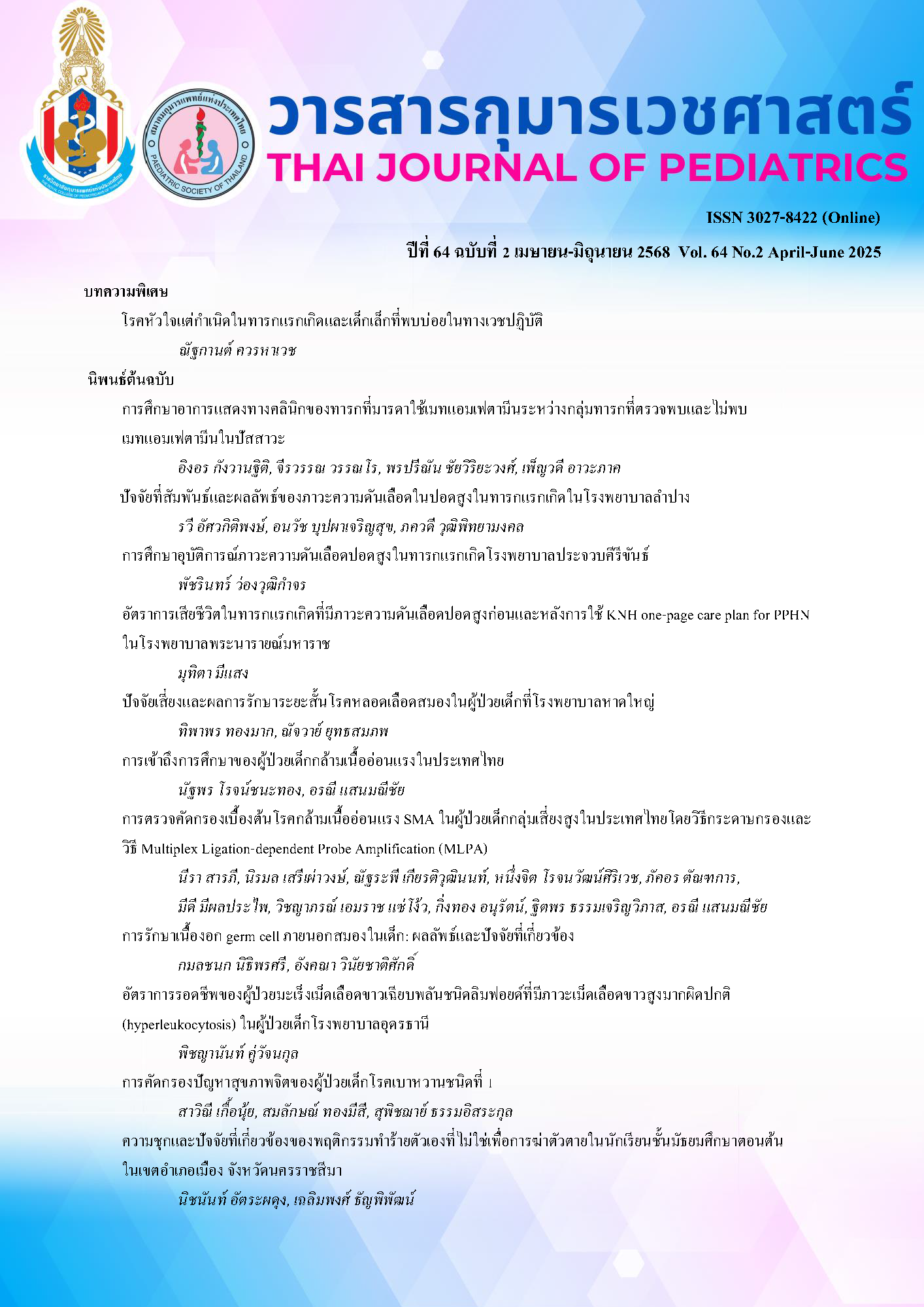Prevalence and associated factors of non-suicidal self-injury among high school students in Mueang district, Nakhon Ratchasima Province
Keywords:
NSSI, Suicide, Adolescent, Depression, Self injuryAbstract
Background: Non-suicidal self-injury (NSSI) has increased around the world which affects physical, mental health, and long-term relationships. At present, studies in Thailand were still limited.
Objectives: To study prevalence and associated factors of NSSI among junior high school students in Mueang district, Nakhon Ratchasima Province.
Method: Descriptive cross-sectional study gathered information by stratified sampling method on high school students aged 11 – 15 years old at the affiliated schools in the secondary educational service area office Mueang District, Nakhon Ratchasima Province between May 1, 2024 – December 31, 2024. The collected data included demographics data, The Brief NSSI Assessment Tool, Patient health questionnaire for adolescent, Resilience inventory 9, and revised UCLA loneliness scale 6, all in Thai version.
Results: The total number of students were 1,388 cases and 436 (31%) cases reported at least one NSSI. Factors significantly associated with NSSI included female gender, being a victim of bullying, neglectful, depression, high levels of loneliness, and low resilience.
Conclusion: NSSI is found to be high among junior high school students in Mueang District, Nakhon Ratchasima Province, and is related to many factors, especially depression.
Downloads
References
American psychiatric association. Diagnostic and statistical manual of mental disorders, fifth edition, text revision (DSM-5-TR). Arlington,.VA: American psychiatric association. 2022:923-6.
Hawton K, O’Connor RC, Saunders KE. Suicidal behavior and self-harm. In: Thapar A, Pine DS, Leckman JF, Scott S, Snowling MJ, Taylor EA, eds. Rutters child and adolescent psychiatry. Chichester: John Wiley & Sons, Ltd. 2015:893-910.
Lim KS, Wong CH, McIntyre RS, Wang J, Zhang Z, Tran B, et al. Global lifetime and 12-month prevalence of suicidal behavior, deliberate self-harm and non-suicidal self-injury in children and adolescents between 1989 and 2018: A meta-analysis. Int J Environ Res Public Health. 2019; 16:4581.
Giletta M, Scholte RH, Engels RC, Ciairano S, Prinstein MJ. Adolescent non-suicidal self-injury: A cross-national study of community samples from Italy, the Netherlands and the United States. Psychiatry Res. 2012;197:66–72.
Jeong JY, Kim DH. Gender differences in the prevalence of and factors related to non-suicidal self-injury among middle and high school students in south korea. Int J Environ Res Public Health. 2021;18:5965.
Garisch JA, Wilson MS. Prevalence, correlates, and prospective predictors of non-suicidal self-injury among New Zealand adolescents: Cross-sectional and longitudinal survey data. Child Adolesc Psychiatry Ment Health. 2015;9:1-11.
เวธนี อุบลศรี, ศิริรัตน์ อุฬารตินนท์. การศึกษารูปแบบและลักษณะของพฤติกรรมการทำร้ายตนเองที่ไม่ใช่เพื่อการฆ่าตัวตายในผู้ป่วยวัยรุ่น.วิทยานิพนธ์เพื่อวุฒิบัตรแสดงความรู้ ความชำนาญสาขาจิตเวชศาสตร์เด็กและวัยรุ่น. กรุงเทพฯ: สถาบันสุขภาพเด็กแห่งชาติมหาราชินี. 2564.
Panyawong W, Pavasuthipaisit C, Santitadakul R. Validation of the Thai version of the patient health questionnaire for adolescents (PHQ-A) in adolescent psychiatric patients. Int J Child Dev Ment Health. 2020;8:30-40.
Wongpakaran N, Wongpakaran T, Pinyopornpanish M, Simcharoen S, Suradom C, Varnado P, et al. Development and validation of a 6‐item revised UCLA loneliness scale (RULS‐6) using rasch analysis. Br J Health Psychol. 2020;25:233-56.
Wongpakaran N, Wongpakaran T. 9-Item resilience inventory [Internet]. 2020 [cited 2022 Feb 1]. Available from: https://www.pakaranhome.com/index.php?lay=show&ac=article&Id=214760232
Vadivel R, Shoib S, Halabi SE, et al. Mental health in the post-COVID-19 era: Challenges and the way forward. Gen Psych. 2021;34:e100424.
Liu Y, Yue S, Hu X, Zhu J , Wu Z , Wang J, et al. Associations between feelings/behaviors during COVID-19 pandemic lockdown and depression/anxiety after lockdown in a sample of Chinese children and adolescents. J Affect Disord. 2021;284:98–103.
Tang J, Li G, Chen B, Huang Z , Zhang Y , Chang H, et al. Prevalence of and risk factors for non-suicidal self-injury in rural China: Results from a nationwide survey in China. J Affect Disord. 2018;226:188–95.
นิดา ลิ้มสุวรรณ. การทำร้ายตัวเองในเด็กและวัยรุ่น (Self-harm in children and adolescents). พิมพ์ครั้งที่ 1. กรุงเทพฯ: สำนักพิมพ์จุฬาลงกรณ์มหาวิทยาลัย, 2025: 47-50.
Ungar M, Liebenberg L, Boothroyd R, Kwong W, Lee T, Leblanc JC, et al. The study of youth resilience across cultures: Lessons from a pilot study of measurement development. Res Hum Dev. 2008;5:166–80.
Wang H, Wen S, Wang Y, Zhou Y, Niu B. Rumination, loneliness, and non-suicidal self-injury among adolescents with major depressive disorder: The moderating role of resilience. Soc Sci Med. 2025;364:117512.
Downloads
Published
How to Cite
Issue
Section
License
Copyright (c) 2025 The Royal College of Pediatricians Of Thailand

This work is licensed under a Creative Commons Attribution-NonCommercial-NoDerivatives 4.0 International License.



